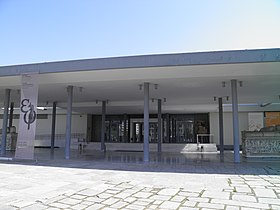Archaeological Museum of Thessaloniki
Αρχαιολογικό Μουσείο Θεσσαλονίκης | |
 An exterior view | |
 | |
| Established | 1912 |
|---|---|
| Location | M. Andronikou 6, GR-54621, Thessaloniki, Central Macedonia, Greece |
| Coordinates | 40°37′30″N 22°57′14″E / 40.62500°N 22.95389°E |
| Type | Archaeological |
| Director | Polyxeni Adam-Veleni |
| Website | Official website |
The Archaeological Museum of Thessaloniki (
The building and the exhibitions

The museum is housed in a building designed by architect

The central rooms hold exhibits from the archaeological excavations conducted in Thessaloniki and the broader area of
At present, the collection of Archaic to
Apart from its permanent displays, the Archaeological Museum also hosts major temporary and thematic exhibitions. In the Manolis Andronikos Room, for instance, there is an exhibition titled The Coins of Macedonia from the 6th Century to 148 BC, with examples of coins that were circulating in Macedonia in that period. A showcase in the lobby of the museum displays some finds from the excavation of the Neolithic settlement at Makrygialos in Pieria, accompanied by information about the progress of the excavation.
In the new wing, the Gold of Macedon exhibition includes finds from numerous excavations in
The Thessaloniki in Prehistory exhibition aims to recreate a picture of the
Discovery of possible original statue of Alexander
On 26 February 2010, Greek authorities arrested two men found in illegal possession of various antiquities, including a bronze statue of Alexander, which is possibly a work of Lysippos. If confirmed, this would make it the first original work of Lysippos ever discovered. The statue is currently being examined at the laboratory of the museum, which is expected to confirm or deny its authenticity.[2][3]
Notable exhibits

- Derveni krater
- The statue of Harpocrates (2nd century AD)
- The Head of Serapis (2nd century BC)
- Bronze helmet and gold mask (cemetery of Sindos, end of 6th century BC)
- Marble door (Macedonia tomb of Agia Paraskevi)
- Copy of "Unveiling" Aphrodite (421/420 BC)
- Gold medals (250–225 BC)
- Inlaid floors (mosaic)
- Gold diadems, gold disks and gold Medusa heads (350-325 BC)
- Derveni Papyrus (end of 5th century BC)
- Plaster castings of Las Incantadas (the originals are in the Louvre)
Gallery
-
Red figure pottery (4th BC)
-
Facade of an ancient Macedonian tomb (4th BC); 6.5m long, 4m wide and 4.8m high
-
Inscription reading: "To Queen Thessalonike, (Daughter) of Philip"
-
Restored parts from the Temple of Aphrodite, located in Thessaloniki, almost completely buried
-
Gold diadem consisting of 8 lyre-shaped sections, decorated with acanthus leaves, tendrills and palmettes (320-300 BC)
-
The Derveni Krater (vase for mixing wine and water)
-
Macedonian coins
-
Exhibition of the "Gold of Macedon"
-
Macedonian helmet
-
Macedonian golden wreath
-
Another golden wreath
-
Bronze calyx krater
-
Bronze figurines of Hermes and Heracles
-
Votaive plaque (1st BC)
-
Marble statue of Augustus (Roman period)
-
Epona, patroness of horses. Celtic goddess, may have been introduced in Thessaloniki by Galerius
-
Funerary relief depicting a family (1st AD)
-
Philosopher (150-60 AD)
-
Marble statue of Dionysus (2nd AD)
-
Head thought to be a portrait ofAlexander The Great(175-200 AD)
-
Dionysiac composition (200-250 AD)
-
Head of an old man (3rd AD)
-
Mosaic depicting "Winter" (3rd AD)
See also
References
- ^ Museums of Macedonia web site
- ^ "Αγαλμα του Μεγάλου Αλεξάνδρου βρέθηκε στην κατοχή αρχαιοκαπήλων". In.gr.
- ^ e-go.gr, Pegasus Interactive. "Αγαλμα – έκπληξη στα χέρια των αρχαιοκάπηλων". ethnos.gr. Archived from the original on 4 March 2010. Retrieved 23 July 2016.
























